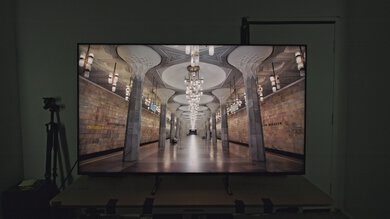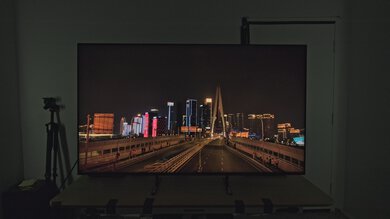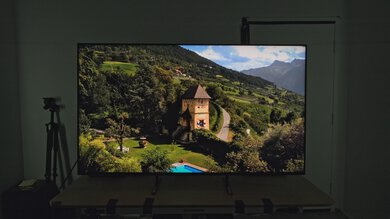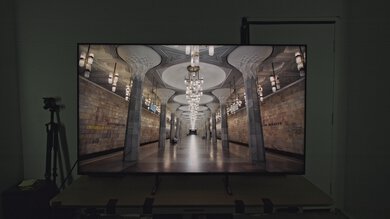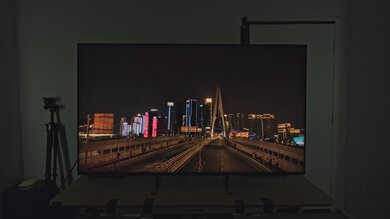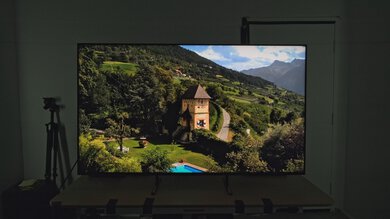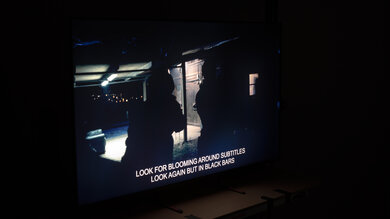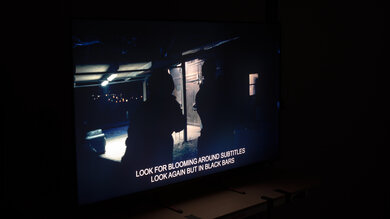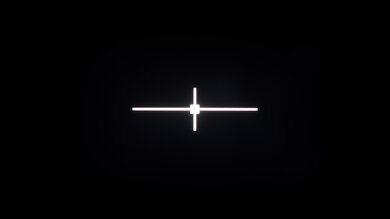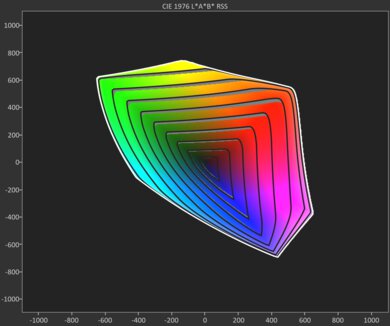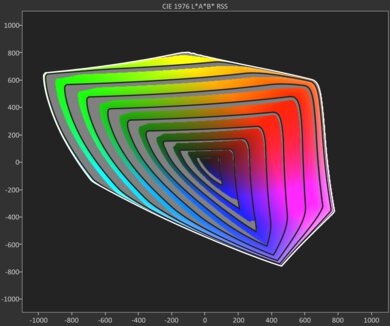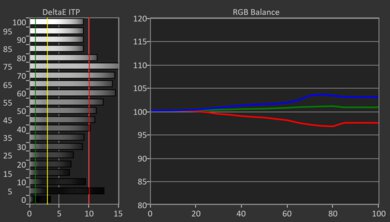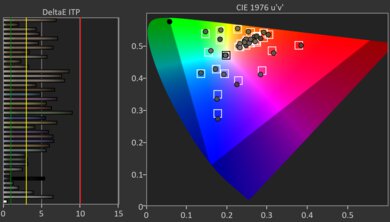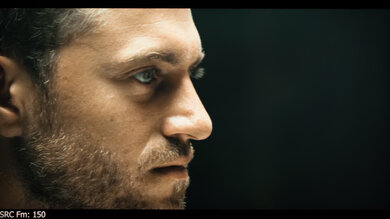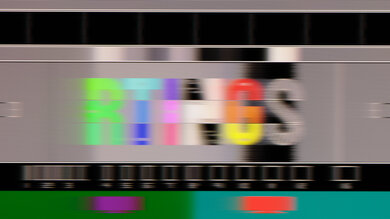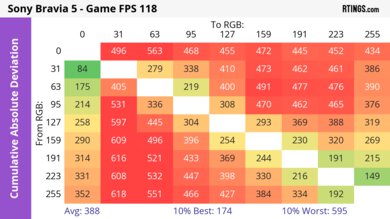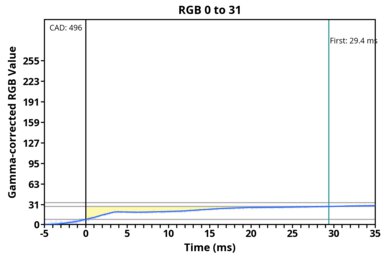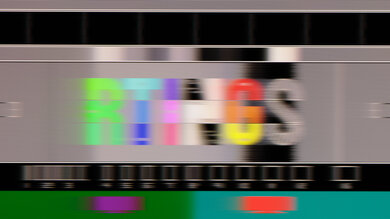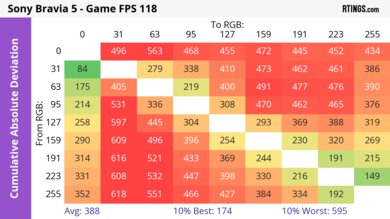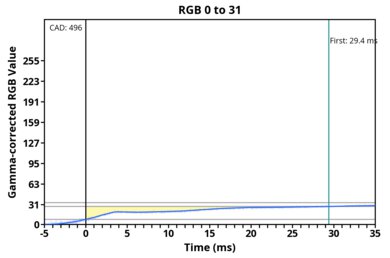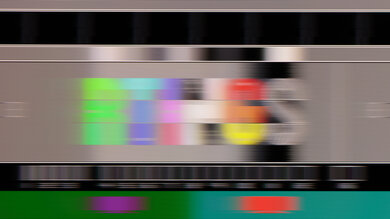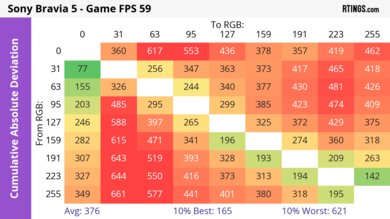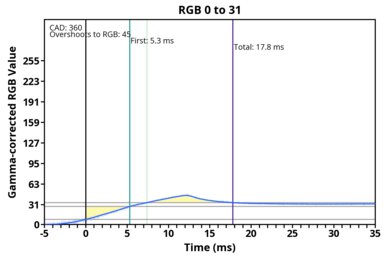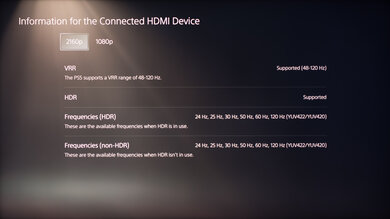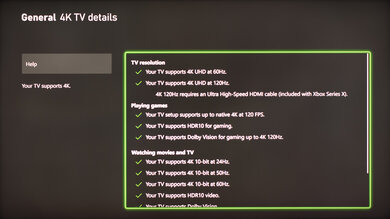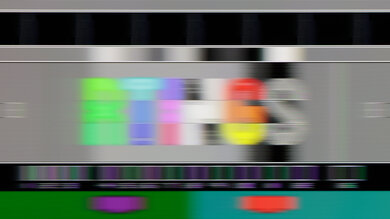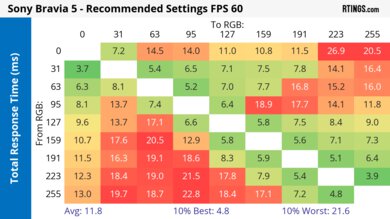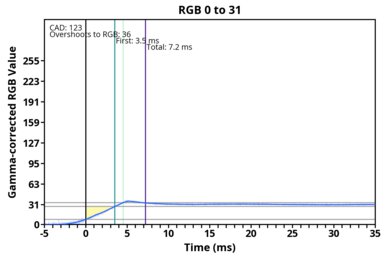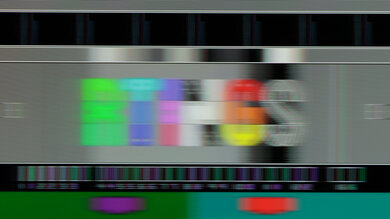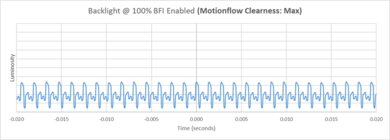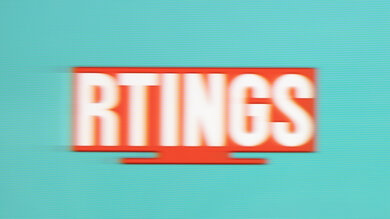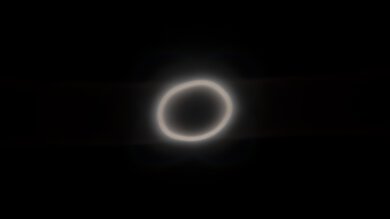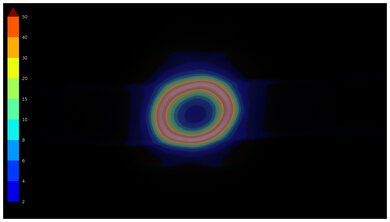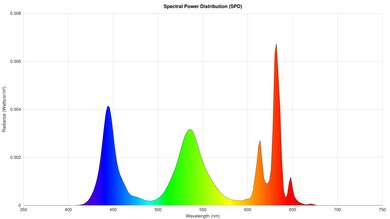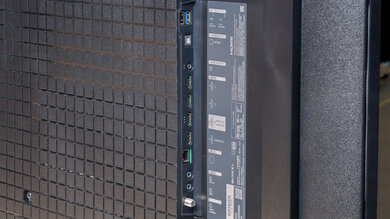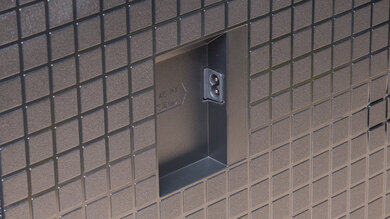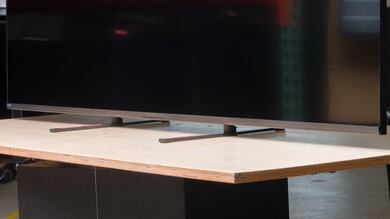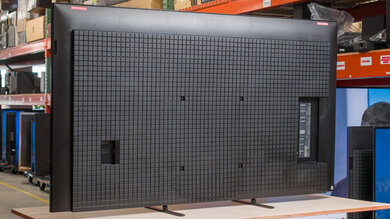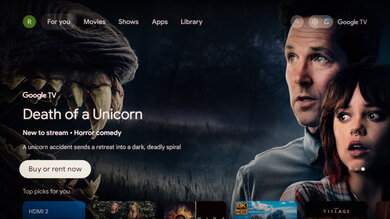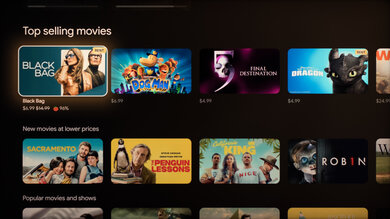The Sony BRAVIA 5 is the follow-up to the popular Sony X90L/X90CL that was released in 2023. It sits in the middle of Sony's 2025 LED TV lineup, above the Sony BRAVIA 2 II and Sony BRAVIA 3, and below the Sony BRAVIA 7 and Sony BRAVIA 9 QLED. Unlike its predecessor, which used a standard LED panel with minimal dimming zones, the new model uses a Mini LED backlight and has up to six times the amount of dimming zones, depending on the size. It uses Sony's XR processor that's found in most of their TVs and runs version 12 of the popular Google TV OS. It supports Dolby Vision, DTS audio passthrough, and you can use its built-in speakers as a center channel when paired with compatible Sony soundbars and receivers. For gamers, it has HDMI 2.1 bandwidth on two ports for up to 4k @ 120Hz with either G-SYNC or HDMI Forum VRR. We bought and tested the 65-inch model, and it's also available in 55, 75, 85, and 98-inch models.
Our Verdict
The Sony BRAVIA 5 is satisfactory for mixed usage. It looks decent in reference conditions, with fairly deep blacks and vibrant enough colors to enjoy, but its mediocre HDR brightness means HDR content lacks the impact it should have. It gets bright enough in SDR to fight glare from indirect lighting, but direct light sources are distracting. Although the TV supports most modern gaming features, its very slow pixel transitions mean motion is blurry, which holds back its gaming performance. Sadly, its narrow viewing angle means it's not great for wide seating arrangements.
-
Very good SDR brightness helps it overcome glare from indirect lighting.
-
Superb upscaling and very good low-quality content smoothing.
-
Colors are vibrant and lifelike.
-
Struggles with reflections from direct sources of light.
-
Very slow pixel transitions in Game Mode leads to blurry motion.
-
Mediocre HDR brightness means some HDR content lacks impact.
The Sony BRAVIA 5 is decent for a home theater. The TV's contrast is good enough that blacks look fairly deep during dark scenes, and the TV's local dimming keeps blooming to a minimum. However, its dimming algorithm struggles with more precise highlights, so blacks look grayish in scenes with small areas of brightness. Highlights and colors in HDR are accurate and stand out somewhat, but they do lack some impact due to the TV's mediocre HDR brightness. Fortunately, it has excellent image processing, so you get a clean image from heavily compressed streams, like YouTube. Since it has a relatively slow response time, there's very little stutter, which is great.
-
Superb upscaling and very good low-quality content smoothing.
-
Colors are vibrant and lifelike.
-
Fantastic PQ EOTF tracking means HDR content has mostly accurate brightness.
-
Very good SDR color accuracy before calibration.
-
Very little stutter during 24fps content.
-
Mediocre HDR brightness means some HDR content lacks impact.
-
Unremarkable HDR color accuracy before calibration.
-
Sometimes falls back on its native contrast ratio, making the image look a bit washed out in dark scenes with complex highlights.
The Sony BRAVIA 5 is good for a bright room. It has very good SDR brightness, which helps it fight glare from indirect lighting. On the other hand, direct reflections are very distracting, so it's best to avoid placing any light source opposite the screen. The TV's black levels and color saturation remain mostly unaffected by ambient lighting, so you get a pleasing image in a bright room.
-
Very good SDR brightness helps it overcome glare from indirect lighting.
-
Colors are vibrant and lifelike.
-
Blacks stay deep in a bright room.
-
Struggles with reflections from direct sources of light.
The Sony BRAVIA 5 is good for watching sports. Direct reflections from light sources opposite the TV screen are distracting, but the TV is bright enough to fight glare from overhead lights or other indirect light sources. Its excellent image processing means cable broadcasts and online streams look clean and sharp, and it displays vibrant enough colors to please you and your friends. However, if you are watching the game with your friends, have them seated as centered to the screen as possible, since the TV's image quality degrades when viewed from the sides of the screen. Unfortunately, it has poor uniformity, so you do see the dirty screen effect during brighter sports, and the corners of the screen are noticeably darker than the center.
-
Very good SDR brightness helps it overcome glare from indirect lighting.
-
Superb upscaling and very good low-quality content smoothing.
-
Colors are vibrant and lifelike.
-
Struggles with reflections from direct sources of light.
-
Very noticeable dirty screen effect and the corners are dimmer than the center of the screen.
The Sony BRAVIA 5 is just alright for gaming. It has HDMI 2.1 bandwidth, 4k @ 120Hz, and VRR, so it's compatible with Sony's, Microsoft's, and Nintendo's latest consoles. It delivers gameplay with very little input lag, which is great for PVP titles. However, the TV has very slow pixel transitions, so fast motion is blurry and lacks clarity. You still get decent overall image quality, with deep enough blacks and vibrant enough colors to enjoy, but the TV's mediocre HDR brightness means the large catalog of HDR games available lacks some impact.
-
HDMI 2.1 bandwidth, up to 4k @ 120Hz, and VRR support.
-
Colors are vibrant and lifelike.
-
Low input lag for a responsiveness feel when gaming.
-
Very slow pixel transitions in Game Mode leads to blurry motion.
-
Only two HDMI 2.1 ports, one of which is also the eARC port.
-
Mediocre HDR brightness means some HDR content lacks impact.
-
Sometimes falls back on its native contrast ratio, making the image look a bit washed out in dark scenes with complex highlights.
The Sony BRAVIA 5 has adequate brightness overall. Its SDR brightness is very good, so the TV cuts through glare from indirect lighting. Sadly, its HDR brightness is mediocre, so even though there's not a huge difference in brightness between small highlights and entirely well-lit scenes, all HDR content lacks some of the impact it's intended to have.
-
Very good SDR brightness helps it overcome glare from indirect lighting.
-
Mediocre HDR brightness means some HDR content lacks impact.
The Sony BRAVIA 5 has adequate black levels. With local dimming enabled, the TV displays fairly deep blacks with minimal blooming. However, due to the way its dimming algorithm works, dark scenes with very small highlights are washed out. It also has disappointing black uniformity, so purely dark scenes are a bit cloudy.
-
Disappointing black uniformity leads to blooming and cloudiness in purely dark scenes.
The Sony BRAVIA 5 has good colors overall. Although this isn't the brightest TV, it still has good color volume in SDR and HDR, so colors are vibrant enough to please the viewer. It also has very good color accuracy in SDR out of the box, so you get a mostly accurate image. However, it has unremarkable HDR color accuracy; if you want an accurate image in HDR, you need to get it calibrated.
-
Colors are vibrant and lifelike.
-
Very good SDR color accuracy before calibration.
-
Unremarkable HDR color accuracy before calibration.
Note: We're in the process of improving our tests related to image processing, but this score should give you a general idea of how a TV performs overall with its image processing capabilities.
The Sony BRAVIA 5 has excellent image processing overall. It has superb upscaling capabilities for low-resolution content, and it does a great job cleaning up artifacts in heavily compressed content, like YouTube. Its gradient handling is very good overall, with only some visible banding in dark greens and blues. Finally, this TV respects the filmmaker's intent when it comes to HDR brightness due to its fantastic PQ EOTF tracking.
-
Superb upscaling and very good low-quality content smoothing.
-
Fantastic PQ EOTF tracking means HDR content has mostly accurate brightness.
-
Only minor banding in some color gradients.
The Sony BRAVIA 5 has alright responsiveness in its dedicated gaming mode. It has modern features like HDMI 2.1 bandwidth on two ports, 4k @ 120Hz, and VRR, so you can take full advantage of the features on your current-gen console. It also has low input lag, so inputs feel responsive. Sadly, this TV's very slow pixel transitions are a major drawback for gamers, since fast motion is quite blurry at both 60Hz and 120Hz.
-
HDMI 2.1 bandwidth, up to 4k @ 120Hz, and VRR support.
-
Low input lag for a responsiveness feel when gaming.
-
Very slow pixel transitions in Game Mode leads to blurry motion.
-
Only two HDMI 2.1 ports, one of which is also the eARC port.
We're in the process of fixing the way we evaluate a TV's overall motion handling. This section is currently broken, and the score isn't indicative of how well a TV handles motion overall.
- 7.2 Mixed Usage
- 7.2 Home Theater
- 7.5 Bright Room
- 7.6 Sports
- 6.7 Gaming
Performance Usages
- 6.7 Brightness
- 6.7 Black Level
- 7.4 Color
- 8.7 Processing (In Development)
- 6.6 Game Mode Responsiveness
- 7.8 Motion Handling (Broken)
Changelog
- Updated Jun 12, 2025: Review published.
- Updated Jun 06, 2025: Early access published.
- Updated May 20, 2025: Our testers have started testing this product.
- Updated Apr 30, 2025: The product has arrived in our lab, and our testers will start evaluating it soon.
- Updated Apr 22, 2025: We've purchased the product and are waiting for it to arrive in our lab.
Check Price
Differences Between Sizes And Variants
We bought and tested the 65-inch Sony BRAVIA 5, but most of our results should also be valid for the 55, 75, and 85-inch models. However, based on some results from other reviewers, it seems like there's an increase in brightness as the size of the TV increases. The 98-inch model reportedly also has a big increase in dimming zones, so most of our results aren't valid for that size.
Costco sells a variant of this TV with a slightly different model code that comes with an extended warranty, a backlit remote, and some additional perks, but it performs the same. Sony TVs typically perform the same in North America as in other regions, so our results should be valid for all regions.
| Size | US Model | Warehouse Model |
|---|---|---|
| 55" | K-55XR50 | - |
| 65" | K-65XR50 | K65XR50CB.U2 |
| 75" | K-75XR50 | K75XR50CB.U2 |
| 85" | K-85XR50 | K85XR50CB.U2 |
| 98" | K-98XR50 | - |
Our unit was manufactured in February 2025, as seen in the photo of the label.
Popular TVs Comparisons
The Sony BRAVIA 5 is a disappointing follow-up to the Sony X90L/X90CL. Despite using a Mini LED backlight with more dimming zones, the TV's contrast is only slightly better than its predecessor. It's also noticeably dimmer overall, and its out-of-the-box color accuracy isn't nearly as good. It's still packed with a ton of modern features for both cinephiles and gamers, but its overall picture quality will leave movie fans wanting more, and its very slow pixel transitions really hold back the TV's gaming performance. Sony's industry-leading image processing can only go so far as a selling point, and outside of that, the TV doesn't do anything better than other Mini LED TVs that are significantly cheaper. You're better off buying a TCL QM7K or Hisense U75QG, as both of those TVs offer superior picture quality for much less. You can even find OLEDs for around the same cost as a BRAVIA 5, so it's a really hard TV to recommend to anyone.
For more options, check out our recommendations for the best TVs for bright rooms, the best Mini LED TVs, and the best TVs for gaming.
The Sony X90L/X90CL is better overall than the Sony BRAVIA 5. The X90L is brighter overall, providing a more impactful HDR experience and making it better suited for a well-lit room. Colors are also brighter and punchier on the X90L, and they're more accurate out of the box. On the other hand, the BRAVIA 5 has slightly better contrast, lower input lag, and less stutter, but all of these things are minor, and the X90L is the better option for almost anyone.
The Sony BRAVIA 7 offers superior picture quality over the Sony BRAVIA 5. The BRAVIA 7 has superior contrast with less blooming, is a lot brighter in SDR and HDR, and has the advantage when it comes to color vibrancy and accuracy. These attributes mean the TV has noticeably better picture quality with all content.
The LG C4 OLED is better than the Sony BRAVIA 5 in almost every way. The LG displays inky blacks with no blooming around highlights and is significantly brighter in HDR, giving its image more depth. The LG is the superior gaming TV, with much sharper motion and 144Hz support. If you have a large living room with a wide seating arrangement, the LG is the better choice due to its wider viewing angle. Although the Sony is brighter in SDR, its reflection handling is worse, so both TVs perform similarly in a bright room. The Sony does have the edge with upscaling and stutter performance, but these advantages are minor, and the C4 is the better option for most people.
The TCL QM7K is mostly better than the Sony BRAVIA 5. The TCL is brighter in SDR and has superior reflection handling, so it's the better option for a bright room. The TCL also displays brighter highlights in HDR content thanks to its higher HDR peak brightness. Blacks are also much deeper on the TCL thanks to its better contrast. For gamers, the TCL is the better option thanks to its quicker pixel transitions, which lead to clearer motion in fast-paced games. Furthermore, the TCL supports 4k @ 144Hz and 1080p @ 288Hz, making it more versatile for PC gamers. On the other hand, the Sony has better image processing, so it has better upscaling, superior low-quality content smoothing, and less banding in color gradients.
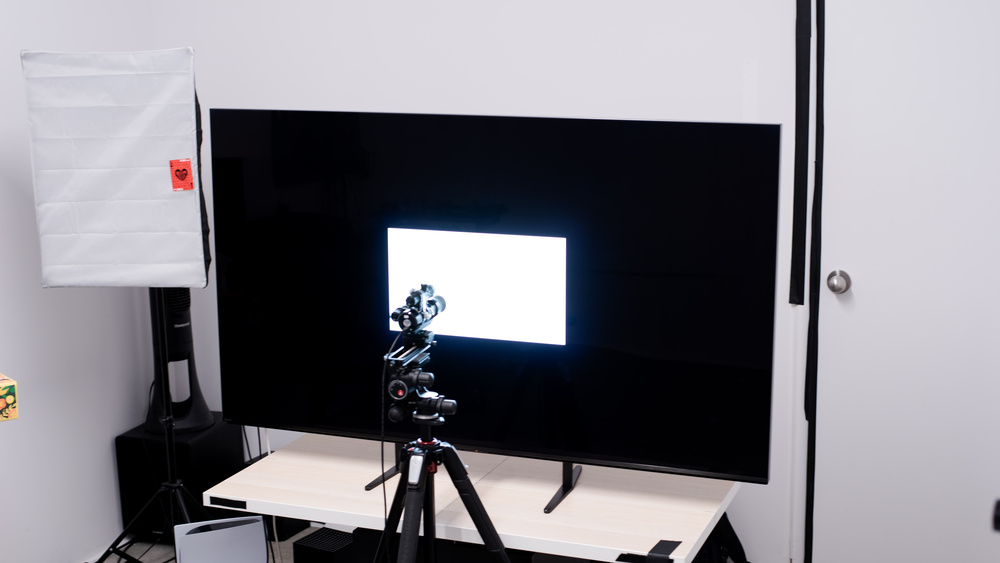
We buy and test dozens of TVs yearly, taking an objective, data-driven approach to deliver results you can trust. Our testing process is complex, with hundreds of individual tests that take over a week to complete. Most of our tests are done with specially designed test patterns that mimic real content, but we also use the same sources you have at home to ensure our results match the real-world experience. We use two main tools for our testing: a Colorimetry Research CR-100 colorimeter and a CR-250 spectroradiometer.
Test Results
The Sony BRAVIA 5 has mediocre HDR brightness. It's just bright enough for some highlights to pop in dim and moderately lit scenes, so you still get a somewhat impactful HDR experience. Fortunately, entirely well-lit scenes aren't much dimmer than small highlights, so you don't notice much of a difference in brightness between different scenes.
Unfortunately, the TV is noticeably dimmer in HDR compared to its predecessor, the Sony X90L/X90CL. You can see comparison shots in the Contrast section.
Our results above are with the TV set to Professional with 'HDR Tone Mapping: Gradation Preferred' since those settings give the most accurate image. We also used the 'Auto Local Dimming: Medium' setting since the difference between the high and medium settings barely affects contrast, but you get brighter highlights with it set to medium. The TV's HDR peak brightness depends on the settings used, and you can see some additional measurements below.
| Picture Settings | Hallway Lights (cd/m2) | Yellow Skyscraper (cd/m2) | Landscape Pool (cd/m2) |
|---|---|---|---|
| Auto Local Dimming: High | 342 | 211 | 290 |
| Brightness Preferred (Local Dimming: Medium) | 517 | 319 | 278 |
There's no noticeable difference in HDR brightness when the TV is set to Game Mode. Our results are with 'HDR Tone Mapping: Gradation Preferred' and 'Auto Local Dimming: Medium'. The TV's HDR peak brightness in Game Mode depends on the settings used, and you can see some additional measurements below.
| Picture Settings | Hallway Lights (cd/m2) | Yellow Skyscraper (cd/m2) | Landscape Pool (cd/m2) |
|---|---|---|---|
| Auto Local Dimming: High | 338 | 212 | 183 |
| Brightness Preferred (Local Dimming: Medium) | 512 | 286 | 274 |
| HDR Tone Mapping: Off (Local Dimming: Medium) | 490 | 309 | 208 |
The Sony BRAVIA 5 has very good SDR brightness. Like most TVs, it's not quite as bright when watching content with large areas of brightness, like sports. However, it's fairly consistent across the board, so the TV overcomes glare in well-lit rooms. Despite being the successor to the 2023 Sony X90L/X90CL, this TV is dimmer than that model.
The Sony BRAVIA 5 has okay contrast, resulting in deep blacks during most dark scenes. However, black levels are raised when very bright highlights are on screen. There's barely a difference in black levels between the 'Medium' and 'High' local dimming settings, but you get brighter highlights with the medium setting, so that's what we used during testing. With 'Auto Local Dimming: High', the contrast ratio is 53827:1. Despite having a Mini LED backlight with more dimming zones than the Sony X90L/X90CL, the two TVs have a very similar contrast ratio.
Our testing doesn't show the whole picture, though. Although scenes with pure blacks and large bright elements look almost the same on both TVs, darker elements (near-blacks) are noticeably deeper on the BRAVIA 5 in some real scenes. This is visible in person, but we've included some comparison shots of the BRAVIA 5 positioned above the X90L so you can compare them for yourself. It's easier to spot the differences in the high ISO photos. For example, the woman's dark outfit in the 'High ISO 8' photo is noticeably deeper on the BRAVIA 5.
The regular ISO photos are a good way to see the difference in brightness between the two TVs. The 'Regular ISO 2' and 'Regular ISO 7' are very good examples.
The TV has good lighting zone precision overall, but the TV takes a conservative approach to how it controls blooming. Even though it has more dimming zones than the Sony X90L/X90CL, there's a large averaging of zones, so it isn't very precise with small highlights. This means that it often falls back to its native contrast ratio, especially during more challenging scenes.
For example, if you're looking at a starfield, the stars aren't crushed like they can be on some TVs, but the black areas between stars aren't very deep. This is because it doesn't dim its zones for scenes like this, so you don't see any blooming, but the whole image looks a bit washed out.
You can see an example of this behavior in this image. The picture is overexposed to more clearly show the dimming behavior, so it doesn't look nearly as bad in person. The small bright dot in the middle of the screen is a mouse cursor, and the blueish area around it are the zones that aren't being dimmed.
The TV has good lighting zone transitions overall. It does struggle a bit with fast-moving content, so there's some haloing and the leading edge of quick-moving objects is visibly dimmer.
The Sony BRAVIA 5 has disappointing black uniformity. With local dimming disabled, the TV is bluish with very apparent cloudiness across the screen. With local dimming enabled, blacks are deep, but there's noticeable blooming and cloudiness around some highlights.
The TV's SDR color volume is good overall. It has great coverage of the DCI-P3 color space, only struggling a bit with some lighter shades of color. Its coverage of the wider BT.2020 color space is noticeably worse, and it struggles a lot more with all colors.
| Volume ΔE³ | DCI-P3 Coverage | BT.2020 Coverage |
|---|---|---|
| L10 | 89.47% | 67.04% |
| L20 | 91.05% | 68.32% |
| L30 | 91.15% | 68.48% |
| L40 | 90.94% | 70.25% |
| L50 | 90.74% | 70.52% |
| L60 | 90.19% | 69.78% |
| L70 | 90.14% | 67.03% |
| L80 | 89.81% | 63.96% |
| L90 | 89.52% | 63.72% |
| L100 | 91.31% | 84.77% |
| Total | 90.34% | 68.15% |
The Sony BRAVIA 5 has good HDR color volume. Most dark, saturated colors are displayed well, but it struggles a bit with bright whites and most bright colors. It's still good enough for a vibrant viewing experience, but very bright colors don't pop off the screen as much as they do on similar TVs such as this one's predecessor, the Sony X90L/X90CL.
The Sony BRAVIA 5 has very good SDR pre-calibration accuracy. Gamma is pretty close to 2.2, but most scenes are displayed darker than intended. Its white balance is very good overall, but reds and greens are a bit underrepresented, while blues are a bit overrepresented. This contributes to the TV's overly cool color temperature. Still, colors have great accuracy overall, with only minor errors that most people won't notice.
The Sony BRAVIA 5 has outstanding SDR accuracy after calibration, and any inaccuracies with white balance, color temperature, and gamma are gone. The greyscale is easy to calibrate, but there's no color calibration option, so color accuracy remains mostly unchanged.
See our full calibration settings.
The Sony BRAVIA 5 has unremarkable HDR color accuracy before calibration. Blues are very overrepresented in lighter shades of gray, while reds are very underrepresented, making the TV's color temperature significantly too cool. Overall, colors have okay accuracy, but there are mapping errors throughout, most notably in warmer colors.
After calibration, the TV has fantastic HDR color accuracy. Its white balance is much better now, and the color temperature is much closer to the industry standard 6,500K. Color accuracy is significantly improved, with only minor mapping errors that most people won't notice.
The Sony BRAVIA 5 has fantastic PQ EOTF tracking. Near-blacks and highlights are a bit darker than intended, but it follows the curve very closely overall. There's a sharp roll-off near the TV's peak brightness, so most details in specular highlights are lost.
The TV does a great job of smoothing out low-quality content. Compression issues like macro-blocking are smoothed out well without causing any significant loss of fine details. Unlike some other higher-end Sony models, there's no 'Smooth Gradation' setting, so you must use the 'Digital Noise Reduction' setting to clean up low-bitrate content.
The Sony BRAVIA 5 has superb sharpness processing capabilities. Low-resolution content is upscaled well, and lines are sharp enough that the image doesn't look too soft. Fine details in busy scenes are easy to make out, and hardcoded text looks great.
It's worth noting that Sony changed the 'Reality Creation' menu on this model. Unlike previous Sony TVs, it's best to set 'Sharpness' to '50,' 'Reality Creation' to 'Manual,' 'Type' to 'Detailed Preferred,' and the 'Intensity' slider to '4.'
This TV has great gradient handling in HDR. There's some noticeable banding in dark shades of blue and green, but everything else has minimal banding or none at all.
The Sony BRAVIA 5 has excellent input lag while using its dedicated gaming mode. Unlike most other Sony models, the TV's input lag is on par with what you see from competing brands, so you get a very responsive gaming experience, especially at 120Hz. Its input lag is a lot higher outside of its gaming mode, so you do feel a delay when scrolling through menus or pausing content.
The TV supports all common resolutions up to 4k @ 120Hz on two of its four HDMI ports. Chroma 4:4:4 signals are displayed properly with all supported resolutions when the TV's 'Content Type' is set to Game or PC, which is important for text clarity.
The Sony BRAVIA 5 supports variable refresh rate technology to reduce screen tearing. HDMI Forum VRR and G-SYNC compatibility work over the entire refresh rate range, but it doesn't support FreeSync. However, as long as you have an AMD Radeon card from the past four years or so, you can use HDMI Forum VRR instead of FreeSync.
The Sony BRAVIA 5 has poor pixel transitions at 60Hz. Like at 120Hz, its response time in Game Mode is very slow across the board, and there's also more noticeable persistence blur at lower refresh rates, so fast motion is very blurry.
With the exception of 1440p, the TV is fully compatible with everything the PS5 offers, like 4k @ 120Hz, as well as HDMI Forum VRR. It also supports Auto Low Latency Mode, so you don't have to manually switch to Game Mode to get the lowest input lag.
With the exception of 1440p and FreeSync Premium Pro, the TV is fully compatible with everything the Xbox Series X|S offers, including 4k @ 120Hz, HDMI Forum VRR, and Dolby Vision gaming. It also supports Auto Low Latency Mode, so you don't have to manually switch to Game Mode to get the lowest input lag.
Since the TV's response time is slow, it has good stutter performance. There's some minor stutter in 24fps movies and shows that's most noticeable during slow panning shots, but it's subtle and not everyone will notice it.
This TV removes 24p judder from any source, including those that output content in 60Hz, which helps with the appearance of motion in movies and shows.
The Sony BRAVIA 5 uses pulse width modulation (PWM) to control the backlight intensity. It flickers at 720Hz in all picture modes, which is high enough that it isn't noticeable, but it can still bother those sensitive to flicker.
With local dimming disabled, the TV is flicker-free at backlight settings between 15 and 50.
There's an optional backlight strobing feature, commonly known as black frame insertion (BFI), which you can enable to improve the appearance of motion. Unfortunately, it doesn't work very well. With the 'Clearness' slider set to '1,' the TV flickers at 120Hz, which causes image duplication with 60 fps content. With the 'Clearness' slider set to '2,' the backlight flicker pattern is very unusual, flickering at both 120Hz and an underlying 720Hz pattern, similar to the Sony X90L/X90CL.
The Sony BRAVIA 5 has an optional motion interpolation feature to improve the clarity of motion. It works well with smoothing out motion in slower-moving scenes when you use the settings conservativity. Unfortunately, it doesn't work well with more aggressive settings, and there are very noticeable artifacts, haloing, and the TV periodically stops interpolating altogether.
The Sony BRAVIA 5 has inadequate direct reflection handling. Direct light sources like a lamp or window opposite your screen are very noticeable since the TV barely reduces the intensity of those reflections.
There's only some minor black level raise in a room with ambient lighting, so you still get deep blacks with your lights turned on.
The TV's perceived color volume in a bright room is very good. Colors barely lose any saturation when they're exposed to light, so you still get punchy colors in a well-lit room.
The Sony BRAVIA 5 has an alright viewing angle. The image looks mostly consistent from a slight angle, but there's significant gamma shifting, black level raise, and color washout that worsens the further you move off-center. Since image quality is noticeably degraded at an aggressive angle, the TV isn't a very good choice for wide seating arrangements.
Unfortunately, the TV has poor gray uniformity. There's dirty screen effect towards the center, the corners are much darker than the rest of the screen, and there's vertical columns across most of the panel. All of this is most noticeable during brighter scenes and is distracting. The uniformity in darker scenes is much better, but the sides of the screen are a bit lighter than the rest of the image.
The uniformity of a panel can vary between different units of the same TV, so it's very possible that other units aren't as bad as ours.
This TV uses a BGR subpixel layout. It doesn't affect picture quality but can cause issues with text clarity in some applications when using it as a PC monitor.
It uses a KSF phosphor coating to produce red light and has high peaks on reds and blues. This model does have good separation between colors, giving it solid color purity and a wide color gamut.
HDMI ports 3 and 4 support the full 48Gbps bandwidth of HDMI 2.1, while HDMI 1 and 2 are limited to HDMI 2.0 bandwidth. HDMI 3 is also the eARC port.
This TV supports eARC, which allows you to pass high-quality, uncompressed audio to a compatible receiver through an HDMI cable. It supports all major audio formats, so you don't have to worry about compatibility with external sources.
The Sony BRAVIA 5 looks very similar to the Sony X90L/X90CL. It has a premium design with thin bezels, so it has a clean and modern look.
Like the Sony X90L/X90CL, the TV comes with two feet, but these ones are flat on the bottom. However, you can't widen the position of the feet like you can on the X90L and some other Sony models. You can adjust the height of the feet, though. The lower position (pictured above) gives you the best stability, but you can also raise the feet if you need to fit a soundbar underneath the TV.
Like any modern Sony TV, the back has a checkerboard pattern. The inputs are on the left side of the TV in a recessed cutout, so even though they're still reachable when you have it wall-mounted, they're a bit hard to access. Unfortunately, there are no clips or grooves to help with cable management.
Unfortunately, like most TVs, the interface contains ads. You can opt out of personalized ads, but this doesn't change the number of ads you'll see; they just won't be personalized to match your search and viewing history.
The Sony BRAVIA 5 has a good frequency response. Like most TVs, there's not much bass, so it's best to pair it with a soundbar if you want immersive audio. Fortunately, the TV's sound profile remains mostly balanced across all volume levels, so dialogue is clear enough to understand regardless of how loud you have the speakers.
Comments
Sony BRAVIA 5: Main Discussion
Let us know why you want us to review the product here, or encourage others to vote for this product.
We’ve just released a new video that mentions the Sony BRAVIA 5 here.
- 21010
Let me just say that I have a Bravia KDL 55W809C from 2015. It still works perfectly and it’s great, but my concern that it might break makes me think about buying a new model… I was considering the Bravia 5 from 65 but according to Rtings the ratings have been disastrous compared to the Bravia 7 and honestly I didn’t expect that… I’ve never used HDR and I don’t think I ever will… What do you recommend? i have direct light
- 10-11-1
I’m extremely disappointed with my Sony Bravia 9 TV (Model K-85XR90), purchased from Reliance Digital in Hyderabad, India, just 9 months ago. Despite being under Sony’s standard one-year warranty, the TV has been completely unresponsive, like a dead duck, for over 15 days which is under Sony service/repair. The Sony authorized service center technical team diagnosed thrice to confirm critical component failures, including main board and power board, issues without identifying and confirming external causes. After replacing the main board and power board, the TV switched on with a display, but Wi-Fi settings and connectivity issues persisted. Further diagnosis is required to resolve the connectivity problem. Given the replacement of two critical components during the warranty period and the persistence of Wi-Fi issues, I strongly believe that the TV is defective. Given the recurring issues, it’s likely that further glitches and performance problems will arise going forward, underscoring the need for a more comprehensive solution. The complete lack of response from Sony India and the authorized service center is forcing me to consider accepting the same TV repaired by them. Throughout the authorized technical team’s multiple attempts to diagnose the TV, I observed that the TV was handled with inadequate care. I mentioned this in my previous communication. During the third repair attempt, the team spent an hour struggling to remove a back panel screw due to improper fixation, resulting in damage to the screw and partial damage to the back panel. Additionally, the display panel was left with fingerprints and dirt, indicating inadequate care and attention to detail. Hence, I requested that Sony India replace the defective TV with a new unit under standard warranty terms. Having closely observed and inspected the internals, I have concerns regarding potential quality control issues, may be linked to cost-cutting initiatives that compromise the product’s integrity, resulting in defective units or a broader manufacturing problem, IMHO. Given the premium pricing and “cinema is coming home” tagline promise seems hollow given this flagship model, like the Sony Bravia 9 TV, fails so catastrophically within the Sony standard warranty period. This incident raises serious concerns, questions about Sony’s quality standards and the reliability of their other TV models…? As a long-standing Sony loyalist, I’m dismayed by the subpar customer support, and service levels exhibited by Sony India throughout this process. This falls short of the exceptional standards I’ve come to expect from Sony globally. I’ve attempted to escalate this issue to Sony Global Headquarters, hoping for a more satisfactory and comprehensive resolution, but I await further response.
- 43230
Just curious if anyone who owns this tv, did you get a firmware update recently?? I went back in to my local BB and after changing the settings on the X90L and Bravia 5 which are side by side, the Bravia 5 looked much much better than the last time I went in there and looked at it. The X90L still had some slightly brighter highlights, but the color and blooming looked substantially better on the Bravia 5.
Anyone??
- 21010
I come from a Sony KDL55W809C (10 years in November) and I will either get this Bravia 5 or the 65-inch Bravia 7… I am someone who focuses a lot on energy savings; I look for the best performance/energy consumption ratio. I don’t use HDR (also because I don’t have it and I’m fine without it) also because I’ve seen it on Sony OLEDs and it doesn’t change much… Would you not recommend this? My old TV consumes 75 Watts, this one at 65 inches consumes 65 Watts, the TCL reaches 120 with HDR exceeding 200… You understand that I’m almost compelled to take either this one which has an HDR consumption of 90 or the Bravia 7 at 109… I also have a bright room with direct light sources, what do you recommend?
- 32120
I guess this is Sony’s way of making sure this tier remains separate from the Bravia 7 and Bravia 9. The Bravia 8 II being inferior to the A95L might be their way of getting rid of the A95L in order for the Bravia 9 to become their flagship. I didn’t like how they replaced the A80L with the Bravia 8 2024 model either. I thought the way they approached things in 2023 with the X90L and A95L, and in 2024 with the Bravia 7 and Bravia 9 was the best they’ve done with their most recent full-array local dimming, mini-QLED, and QD-OLED models. Unless the Bravia 5 can do something that the Hisense U6, Hisense U7, TCL QM6K, and TCL QM7K can’t do, I can’t justify paying double or tripple for the Bravia 5 for the same results. I actually enjoyed researching which TV I was going to choose as my first 4K TV back in 2023, as well as my post-purchase research in 2024, which led me back to the X90L I purchased in 2023, which was still being manufactured and was still selling strong. Yet technology is supposed to move forward. So based on how great the X90L and A95L are, I was having high hopes for the direction Sony would take in 2025. However, as an X90L owner and as someone who is dreaming of being able to afford the A95L some time in the future, I am quite disappointed with the direction Sony went in with this tier, as well as their QD-OLED model. I have an extended Costco warranty. So if mine needs a warranty replacement once the X90L sells out, this would force me to decide whether to take a Bravia 5 so I wouldn’t have to pay more, or pay the difference for a Bravia 7. A95L owners would unfortunately be in a similar situation in the event THEY ALSO need a warranty replacement once the A95L sells out. Should they take a Bravia 8 II, a Bravia 9, or a Samsung QD-OLED and give up Dolby Vision? Sony should have at least stuck with what made the X90L great, changed the GUI, added support for Dolby Vision gaming at 120 Hz, and maybe used brighter LEDs. Unless I’m missing something, I hope Rtings’s Youtubers strongly discourage everyone from considering the Bravia 5.
Funny, I have almost the exact same feelings!! Except I don’t have an X90L. It’s pretty clear to me now after 3 years of researching closely, the Bravia 9 is really the only true “best mini led”. No tv is perfect, it just kills me that for the price of one 85” Bravia 9, I can get an 85” QN90D and a 77” S95D and STILL have $$ left over.
- 21010
MOTION on this TV is Great When Setting CLEARNESS all the way up it Gets rid of all MOTION issues in fast moving LIGHT scenes which is 96% of what we watch Smoothness can be put all the way up with CLEARNESS as it Doesn’t interfere when IMAGES are Transitioning from LIGHT to DARK to LIGHT to DARK ect ect = IMAGE SCENES = Movements So I’m not sure how your doing you testing but it needs to change - Thanks
The motion interpolation settings have nothing to do with pixel response time. The motion tests CAD in game mode and response time test the panels physical capability of displaying motion by changing color fast and accurately which this TV like all LCD TVs is not the best at. LCD panels are just slow compared to OLEDs which is exposed in fast motion.
The motion settings you are talking about are tested in the categories BFI(black frame insert) and motion interpolation. Those are about the quality of the software, to what extent the tv can improve the motion quality of thre source.
Like on pretty much every other Sony TV with the XR processor those settings dont work the best. The clarity setting controls backlight strobing and the smoothness setting frame interpolation. Both at maximum looks nothing other than atrocious to me.
The interpolation is very artificial and introduces heavy artifacts when put to 3, I use only min or 1 on my Sony. The backlight strobing caused by the clarity setting causes image duplication on all current sony lcds and does not improve the picture, in fact I get a migraine after 2-3 mins of that. Those observations are in line with rtings test results on this and most other tvs. Rtings recommended settings for motion on XR/X1 Sonys is Cinemotion on High and motion clarity+smoothness both on min. This works the best for me as well.
Edited 1 month ago: typo - 10-12-2
MOTION on this TV is Great When Setting CLEARNESS all the way up it Gets rid of all MOTION issues in fast moving LIGHT scenes which is 96% of what we watch Smoothness can be put all the way up with CLEARNESS as it Doesn’t interfere when IMAGES are Transitioning from LIGHT to DARK to LIGHT to DARK ect ect = IMAGE SCENES = Movements
So I’m not sure how your doing you testing but it needs to change - Thanks


